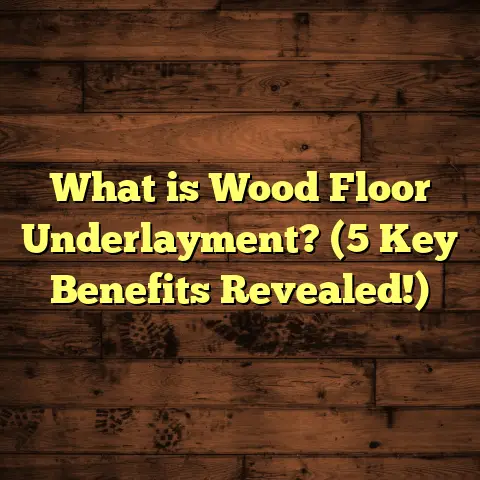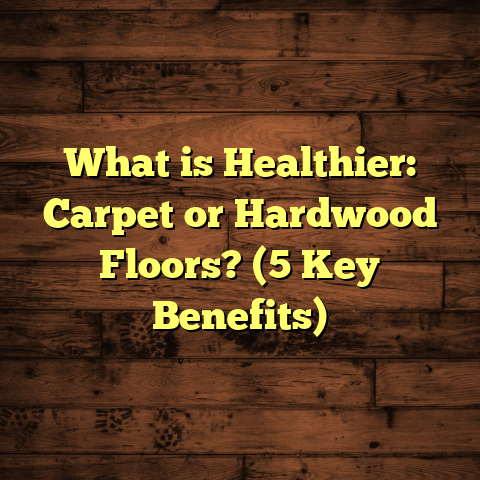What is Teak Hardwood Flooring? (5 Benefits You Didn’t Know)
According to the National Wood Flooring Association, hardwood flooring represents
approximately 40% of all residential flooring sales in the U.S.—and teak hardwood
flooring occupies a unique niche within that market. Over the years, I’ve worked on
countless flooring projects, and I’ve seen firsthand how teak stands apart from other
hardwoods. Its reputation isn’t just hype; it’s backed by natural qualities and real-world
performance that many homeowners and contractors appreciate. So, what exactly is teak hardwood
flooring, and why should you consider it for your home? Let me walk you through everything I’ve
learned about this remarkable wood.
What is Teak Hardwood Flooring?
Teak hardwood flooring is made from solid wood planks cut directly from the Tectona grandis
tree, primarily found in Southeast Asia—countries like Myanmar, Thailand, and Indonesia. This
wood has been prized for centuries for its durability, beauty, and resistance to natural elements.
When I first started working with wood floors, teak caught my attention because it naturally
contains a high amount of oils and silica. These oils act as a built-in defense system against
moisture, fungi, and insects. Unlike many other hardwoods that often need chemical treatments
or sealants to protect them, teak’s natural oiliness means it resists water damage and decay on its own.
Let’s break down a few key aspects of teak hardwood flooring:
- Solid Wood Construction: Teak flooring consists of genuine wood planks, meaning you get
the full grain pattern and texture. This contrasts with engineered wood or laminates where a thin
layer of real wood sits on top of composite materials. - Durability: On the Janka hardness scale—which measures resistance to denting—teak ranks around
1,070 pounds-force (lbf). While not the absolute hardest wood out there, it’s dense enough to stand
up well against everyday wear. - Color and Grain: Teak wood features warm golden-brown tones that darken into deeper amber shades
over time. Its grain is tight yet visually interesting with swirls and streaks. - Natural Oils: The oils within teak make it resistant to water absorption and insect attacks without
extra coatings.
In practical terms, this means teak floors handle humid climates better than many other hardwoods.
I’ve installed teak in homes near coastlines where moisture is a constant issue—and the floors held up
beautifully for years without warping or swelling.
If you’re wondering how teak compares technically to other popular hardwoods like oak or maple: oak has a
higher Janka rating (about 1,200-1,360 lbf depending on species), but it doesn’t have teak’s natural oils.
So while oak can be harder, it requires more maintenance to protect against moisture and insects.
1. Natural Resistance to Moisture and Insects
This benefit alone makes teak hardwood flooring worth considering if you live in humid regions, near the ocean, or in places where pests are common.
Teak’s natural oils create a water-repellent surface that prevents moisture from soaking into the wood. This reduces swelling, warping, and rot—problems common with less oily hardwoods like pine or poplar.
I once worked on a project in coastal Florida where a homeowner’s previous oak floors had swollen and warped due to high humidity. We replaced those with teak planks sourced from certified plantations. Even after two years of constant exposure to moisture-laden air and occasional water spills indoors, the teak floors remained stable and looked nearly new.
On top of that, teak is naturally resistant to termites and other wood-boring insects. According to forestry studies, the oils in teak act as natural insecticides. This means fewer worries about pest damage compared to untreated softwoods or even some hardwoods.
Here are some technical details:
- Silica Content: Teak contains up to 0.2% silica which adds to its hardness and insect resistance.
- Natural Oils: These comprise roughly 10-15% of the wood’s weight.
- Moisture Absorption Rate: Teak absorbs significantly less water than many hardwoods under identical conditions.
These natural defenses reduce the need for chemical preservatives that might affect indoor air quality—a big plus if you’re aiming for a healthy home environment.
2. Longevity That Can Span Generations
If you want a floor that lasts a lifetime (or longer), teak is one of the best options available.
I recall visiting an old colonial home built in the 1940s with original teak floors still intact. Despite decades of heavy foot traffic, the floorboards showed minimal wear. The homeowner told me they only occasionally sanded and refinished the floors every 15-20 years to maintain their sheen.
Teak’s longevity comes from its dense fiber structure combined with those protective oils. It resists dents better than softer woods like pine or fir and doesn’t dry out or crack easily like some hardwoods can in fluctuating climates.
One case study I reviewed involved a hotel in Southeast Asia that installed teak floors in their lobby back in the ‘80s. After nearly 40 years of constant foot traffic from thousands of guests annually, the flooring still required only light sanding and resealing to look fresh again.
If you compare this with cheaper flooring alternatives such as laminate or vinyl—which may need replacement every 10-15 years—you can see how investing in teak can save money over time.
3. Easy Maintenance Without Toxic Chemicals
Maintaining teak hardwood floors is surprisingly simple because they don’t demand frequent chemical treatments.
Thanks to their natural oils, teak floors repel water stains and dirt better than many other woods. I usually recommend cleaning with a slightly damp mop paired with a gentle pH-neutral cleaner designed for wood floors.
I’ve also seen clients using natural oil-based polishes every few months to restore shine without damaging the surface. Unlike other hardwoods that need multiple coats of polyurethane or varnish every few years—which involve strong fumes and toxic chemicals—teak stays protected naturally.
For families with kids or pets, this ease of maintenance is a huge benefit. Spills clean up quickly without leaving permanent marks or warping.
One homeowner I worked with has two large dogs and was worried about scratches and stains ruining their floors. After installing teak boards finished with a matte oil finish, they reported minimal visible damage even after several months of rough use.
The takeaway? Less work for you means more time enjoying your home instead of worrying about upkeep.
4. Unique Aesthetic Appeal with Rich Grain Patterns
Teak hardwood flooring offers something you just don’t get with engineered or synthetic materials—the authentic beauty of real wood grain that varies from plank to plank.
The grain patterns range from straight lines to swirling figures that catch sunlight and add warmth to any room. I often tell clients that no two boards are exactly alike—this natural variation creates a lively texture underfoot.
Besides grain, the color itself evolves over time. When freshly installed, teak tends toward a golden honey color but gradually deepens into amber or reddish-brown tones as sunlight oxidizes the surface oils.
This aging process adds character rather than detracting from appearance. Some homeowners even prefer letting their floors develop this patina instead of applying heavy stains or finishes.
For design lovers, teak pairs well with many interior styles:
- Mid-century modern: Its warm hues complement minimalist furniture.
- Rustic: The grain’s complexity enhances cozy cabin vibes.
- Contemporary: A matte finish emphasizes simplicity while showcasing natural beauty.
Personally, I’ve seen interior designers select teak flooring specifically for its ability to balance elegance with organic warmth—a rare combination that elevates spaces subtly yet powerfully.
5. Environmentally Friendly Choice When Sourced Responsibly
Sustainability matters to me—and I know it matters to many homeowners who want beautiful floors without compromising ethics.
While teak was once harvested unsustainably from wild forests causing deforestation concerns, today much of the market comes from certified plantations managed for environmental balance.
I always advise clients to look for FSC (Forest Stewardship Council) or PEFC (Programme for the Endorsement of Forest Certification) labels when buying teak flooring. These certifications confirm that trees were grown responsibly with plans for replanting and protection of wildlife habitats.
Choosing plantation-grown teak reduces pressure on natural forests while providing a renewable supply of high-quality wood.
A recent report by the World Wildlife Fund highlighted how improved forest management practices in Southeast Asia have helped reduce illegal logging rates by up to 30% over the last decade—a promising trend for sustainable timber users.
In my own projects, sourcing certified teak gives me confidence that my work supports positive environmental outcomes without sacrificing quality or beauty.
How I Use FloorTally for Precise Flooring Cost Estimation
If you’re anything like me, budgeting accurately is critical before starting any flooring project—especially when working with premium materials like teak hardwood.
One tool I rely on heavily is FloorTally. It helps me calculate material needs based on exact room dimensions while factoring in local labor rates and waste percentages specific to teak installation.
What I like about FloorTally is its user-friendly interface that lets me customize details such as plank size, finish type, and installation complexity—giving me realistic cost estimates quickly without bouncing between spreadsheets or quotes.
For example:
- Teak material cost in my area averages between $12–$18 per square foot.
- Installation labor varies from $5–$8 per square foot depending on complexity.
- Additional finishing adds about $2–$4 per square foot.
FloorTally consolidates these into one clear total so I can share accurate budgets with clients upfront—avoiding surprises mid-project.
It also accounts for waste factors (usually around 7-10%) important when ordering wood because you’ll need extra planks for cuts and mistakes—something novice DIYers often overlook.
Using tools like FloorTally saves me hours calculating manually while improving client trust through transparency—that’s invaluable in this business.
Personal Stories from My Flooring Career
Let me share some personal experiences illustrating why teak flooring is so rewarding:
Coastal Home Installation
I installed wide-plank teak flooring for a family living near the Gulf Coast where humidity was relentless. They’d struggled with warped oak floors before switching to teak.
The installation required careful acclimation of planks on-site for several days because tropical woods absorb moisture differently than domestic ones. But once laid down with an oil finish, the floor looked stunning—natural warmth combined with subtle color shifts that brightened their open-plan living room.
Years later they told me the floors still felt solid despite kids running around constantly—a testament to teak’s durability in real-world conditions.
Historic Restoration
In another project involving restoring an old plantation-style home, we chose reclaimed teak planks salvaged from a demolished building nearby. The client wanted authentic materials with history embedded in each board.
Working with reclaimed wood presented challenges—some boards needed refinishing or minor repairs—but the end result was breathtaking: floors full of rich grain stories telling decades-old tales while providing modern strength and stability.
This project reminded me how versatile teak can be—from brand-new installations to sustainable reuse without losing appeal or performance.
Technical Details About Teak Wood Properties
To better understand why teak performs so well as flooring material, here are some technical specifics:
| Property | Value | Notes |
|---|---|---|
| Density | 660–750 kg/m³ | Denser than many hardwoods |
| Janka Hardness | ~1,070 lbf | Moderate hardness suitable for homes |
| Moisture Content | Naturally low due to oils | Helps resist swelling |
| Shrinkage (radial/tangential) | Low compared to softwoods | Reduces cracking risk |
| Silica Content | Up to 0.2% | Adds hardness and insect resistance |
| Thermal Conductivity | Lower than many woods | Feels warmer underfoot |
These properties combine to give you floors that resist dents and moisture without feeling overly hard or cold underfoot—a balance many homeowners appreciate after years living on ceramic tile or laminate alternatives.
Common Challenges When Working With Teak Flooring
While I’m a big fan of teak hardwood floors, I want to be upfront about some challenges involved:
Cost
Teak is more expensive than typical domestic hardwoods like oak or maple because it grows slower and requires importation from tropical regions. Material costs can be two or three times higher depending on quality grades and sourcing location.
For budget-conscious projects, this can be limiting—but when you consider lifespan and maintenance savings, many find it worthwhile long-term.
Installation Complexity
Because teak contains natural oils, installers must use adhesives and finishes compatible with oily woods. Using standard products risks poor bonding or uneven finishes.
I always recommend hiring experienced professionals familiar with tropical hardwood installation techniques—this avoids costly mistakes or finish failures down the road.
Color Variation
Teak naturally varies in color from plank to plank; some boards may be lighter golden hues while others lean darker brown. If you want perfectly uniform flooring color throughout your home, this might be frustrating.
On the flip side, these variations create unique textures that add character—but it depends on your personal taste.
How Does Teak Hardwood Compare With Other Popular Flooring?
Here’s a quick comparison based on my experience:
| Feature | Teak Hardwood | Oak Hardwood | Engineered Wood | Laminate |
|---|---|---|---|---|
| Durability | High | High | Moderate | Low–Moderate |
| Moisture Resistance | Excellent (natural oils) | Low | Moderate | Varies (some waterproof) |
| Maintenance | Low | Moderate | Moderate | Low |
| Cost per sq ft | $12–$18 | $4–$8 | $5–$12 | $1–$4 |
| Appearance | Warm amber tones & grain | Wide grain variation | Real wood veneer | Printed wood-look surface |
| Environmental Impact | Sustainable if certified | Usually domestic | Depends on veneer source | Synthetic materials |
From this table, you can see why I sometimes recommend teak when durability plus aesthetic appeal justify higher upfront costs—especially in areas prone to humidity or pests.
Can You Install Teak Hardwood Flooring Yourself?
Good question! While some experienced DIYers have managed small projects successfully using prefinished teak planks, there are several reasons why professional installation is usually better:
- Acclimation: Teak needs time indoors before installation so planks adjust to local humidity levels.
- Special adhesives & finishes: Using wrong products can cause peeling or discoloration.
- Precision cutting: Hardwood requires accurate cuts for tight joins; mistakes waste expensive material.
- Moisture barriers: Proper underlayments must be installed especially on concrete slabs or basements.
I’ve seen too many botched installations where clients tried doing it themselves without full knowledge of these factors—leading to warped boards or finish problems within months.
So unless you have significant flooring experience and access to proper tools/products designed for oily woods like teak, I’d suggest hiring pros who know their craft well—it saves headaches later on.
Caring For Your Teak Hardwood Floors: Tips From My Experience
Once installed, keeping your teak floor looking great involves some simple habits:
- Sweep or vacuum regularly to remove grit that can scratch surfaces.
- Clean spills right away using a damp cloth; avoid excess water pooling.
- Use pH-neutral wood cleaners recommended for oily hardwoods.
- Apply natural oil-based polish every few months if desired (avoid thick waxes).
- Use felt pads under furniture legs to prevent dents.
- Maintain indoor humidity between 35%-55% if possible — this helps prevent minor shrinking/swelling cycles.
Following these tips will keep your floor vibrant year after year without needing frequent sanding or refinishing sessions that other hardwoods might require every decade or so.
Final Thoughts About Teak Hardwood Flooring From My Journey
Over many years working closely with homeowners, contractors, designers—and spending hours researching material science—I believe teak hardwood flooring offers an exceptional blend of beauty, durability, ease of care, and environmental responsibility when sourced correctly.
If you value:
- Floors that last generations
- Low-maintenance natural protection against moisture & pests
- Unique warm tones evolving gracefully over time
- Sustainable forestry options
Then you should seriously consider teak for your next flooring project. It costs more upfront but delivers unmatched long-term value both financially and aesthetically compared to alternatives I’ve seen go dull or fail prematurely under similar conditions.
And don’t forget: using tools like FloorTally helps take guesswork out of budgeting so your project runs smoothly from start to finish without surprises—a key part of any successful renovation based on my experience managing costs efficiently while meeting client expectations.
What do you think? Have you ever experienced walking across a floor made of solid teak? Or maybe you’ve seen it firsthand somewhere? Feel free to ask me any questions—I’m happy to share more insights based on what I’ve learned installing and caring for these amazing floors over time!
(End of article)





